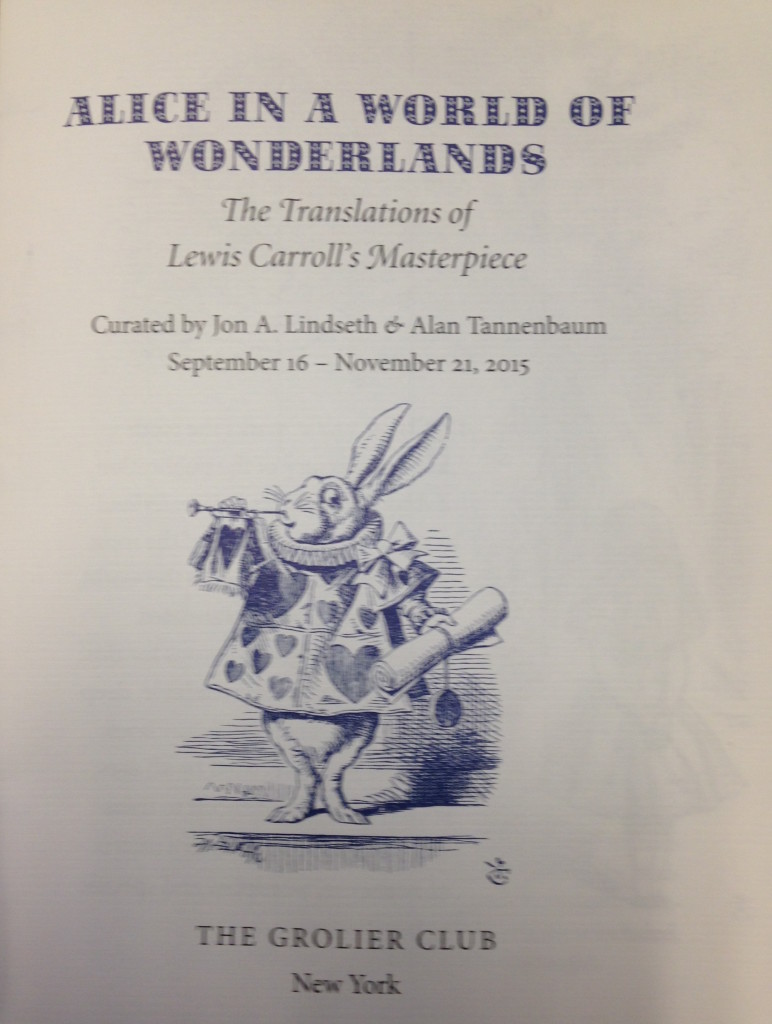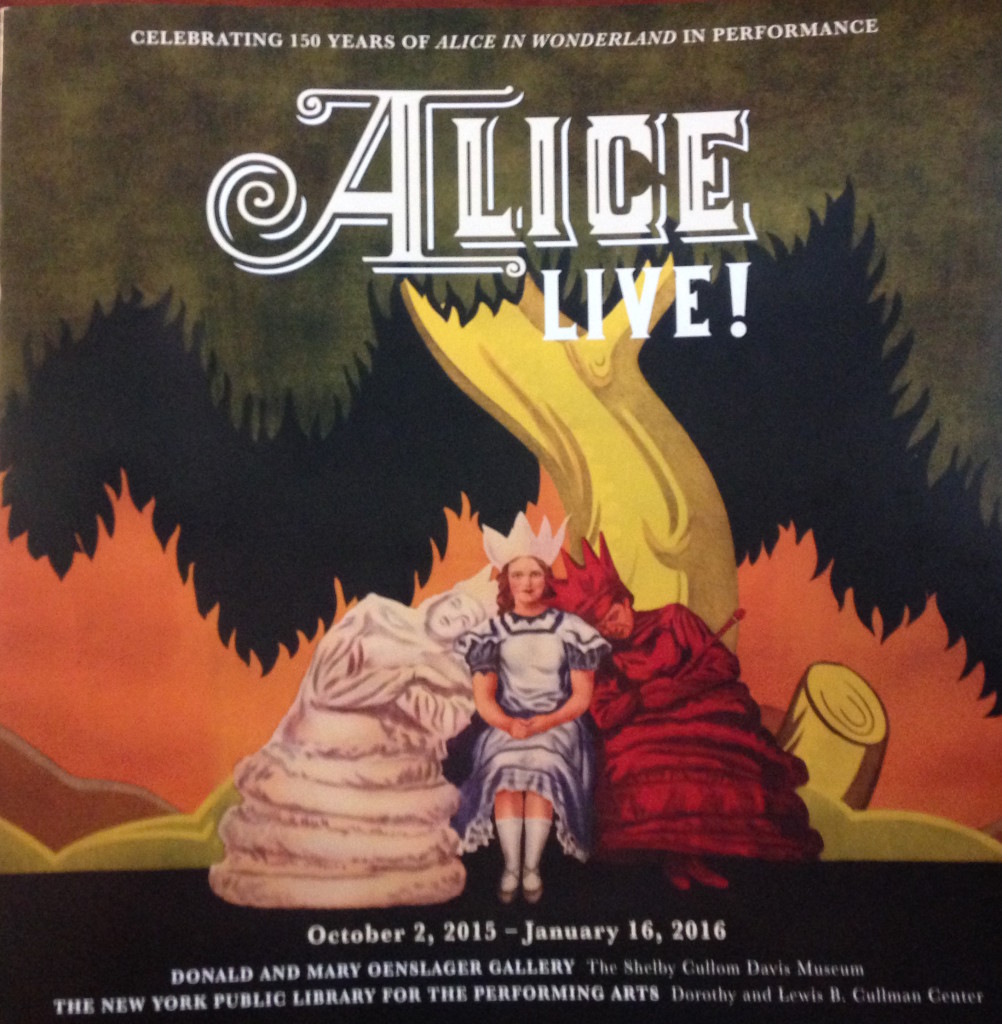Translating, Performing, and Exhibiting Alice
This month is the 150th anniversary of Lewis Carroll’s Alice in Wonderland. I’ve written two recent posts about the Alice books (on Google and in Disney’s 1951 cartoon), which have been close to my heart for a long time now. In college I wrote my math thesis about Charles Lutwidge Dodgson, the Oxford don who wrote the Alice books under his more famous pseudonym. Researching that thesis led me to claims like, “Lewis Carroll invented children’s literature.” Curiosity and skepticism about those claims spurred my interest in graduate studies, and in many ways led to my forthcoming book The Legacy of the Moral Tale (which has only a few pages about Alice).
The sesquicentennial has been a big deal. Scholars, fans, and collectors have been celebrating the books’ un-birthday for most of the year, especially in New York City. I was there for a brief trip last weekend, and had a chance to visit two fantastic exhibits about Alice.
 Through November 21st the Grolier Club is hosting “Alice in a World of Wonderlands: The Translations of Lewis Carroll’s Masterpiece.” Curated by Jon A. Lindseth and Alan Tannenbaum, the exhibit includes materials from their book of the same title. It is housed in a single room on the ground floor, below a 360° library on the second floor. The first few cases cover Carroll himself (including his letters, photographs, and mathematics), translations during his lifetime, and theories of translation. The latter display was a nice touch, giving some theoretical background to the choices made and comparing Alice in Wonderland to Pilgrim’s Progress, the only English novel that exists in more translations than Alice. The case includes example translations from chapter 7, “A Mad Tea Party,” which includes Carroll’s parody of Jane Taylor’s “The Star.” They include a a copy of Taylor’s Rhymes for the Nursery, and explain some of the challenges to translating the poem in particular and Alice in Wonderland in general.
Through November 21st the Grolier Club is hosting “Alice in a World of Wonderlands: The Translations of Lewis Carroll’s Masterpiece.” Curated by Jon A. Lindseth and Alan Tannenbaum, the exhibit includes materials from their book of the same title. It is housed in a single room on the ground floor, below a 360° library on the second floor. The first few cases cover Carroll himself (including his letters, photographs, and mathematics), translations during his lifetime, and theories of translation. The latter display was a nice touch, giving some theoretical background to the choices made and comparing Alice in Wonderland to Pilgrim’s Progress, the only English novel that exists in more translations than Alice. The case includes example translations from chapter 7, “A Mad Tea Party,” which includes Carroll’s parody of Jane Taylor’s “The Star.” They include a a copy of Taylor’s Rhymes for the Nursery, and explain some of the challenges to translating the poem in particular and Alice in Wonderland in general.
The rest of the exhibit is organized by geography or language group, with cases focusing on Great Britain and Ireland, Spanish (the language with the most translated editions), Asia, the Indian subcontinent, and Africa. A final case focuses on Disney’s books (even the company has lost count of how many there are). Also included throughout the exhibit are translations in shorthand, braille, computer code, and experimental alphabets. In the corner of the room, a television is set up showing clips of multimedia translations, including a Japanese version of Disney’s 1951 Alice, a preview for their 2010 film subtitled in Arabic, Svankmajer’s experimental Czech film (1988), and the video game American McGee’s Alice, dubbed (if I recall) in German.
The Grolier Club has a formal, exclusive feel. Only one other couple was present when my wife and I visited, and the room was silent. The “Alice Live” exhibit, held at the New York Library for the Performing Arts, was a different world entirely. The library branch is located at Lincoln Center, which when we visited (on Halloween) was hosting kids’ a trick-or-treating party. We navigated a crowd of superheroes and princesses (and one elaborate Little Red Riding Hood family, complete with a wolfish grandmother in a wheeled bed), many of whom made their way into the exhibit, which includes a scavenger hunt to find images in the displays. Costumed children raced to complete it.
 The exhibit was no less interesting for that additional madness which, frankly, added to the “performance” aspects on which the exhibition focused. At the front of the exhibit are materials related to Dodgson, including his games for children, his fondness for theater and friendships with actresses, and his collaboration with Henry Savile Clarke.
The exhibit was no less interesting for that additional madness which, frankly, added to the “performance” aspects on which the exhibition focused. At the front of the exhibit are materials related to Dodgson, including his games for children, his fondness for theater and friendships with actresses, and his collaboration with Henry Savile Clarke.
On the NYPL blog Charles Lovett, curator of the exhibit and author of Alice on Stage (1989), describes his personal history collecting Alice-related items, especially theatrical memorabilia, and gives a good overview of the exhibit. One of the highlights not mentioned is a series of photographs of actresses who have played Alice, from Phoebe Carlo and Isa Bowman (who starred in Clarke’s production in 1886 and 1888, respectively), through Vivian Tobin (in the first Broadway production, 1915), Josephine Hutchinson (who starred in Eva Le Gallienne’s 1932 production), Meryl Streep (who played Alice in 1981), and ballerina Janessa Touchet (from 2015).
Le Gallienne’s play, revived in 1947 and again in 1982, with Le Gallienne playing the White Queen each time, features prominently in the exhibit, but it includes not just famous mainstays like Clarke’s and Le Gallienne’s adaptations but also Andre Gregory’s 1970s play (the result, the exhibit tells us, of two years of improvisation and experimentation) and dozens of musicals, puppet shows, and dances. One image even documents an underwater Alice in Wonderland, performed by the Weeki Wachee mermaids. (Not mentioned in the exhibit but evident in this video: the show adopts one of the mermaids’ signature tricks, drinking a bottle of coke underwater).
https://www.youtube.com/watch?v=GUZYUN6CdIs.
Overall I found “Alice Live” rather overwhelming. Even the most extensive coverage of a performance was limited to a description, a few pictures, and (at best) a short video. The Grolier Club, in my view, had the slightly easier task: they convey a lot about a translation with just a page and a short description, and the theoretical background was a nice touch. Nevertheless, I enjoyed reading about the performances, and learned about several I hadn’t known about. If you find yourself in New York in the next couple months, both exhibits are well worth the time.